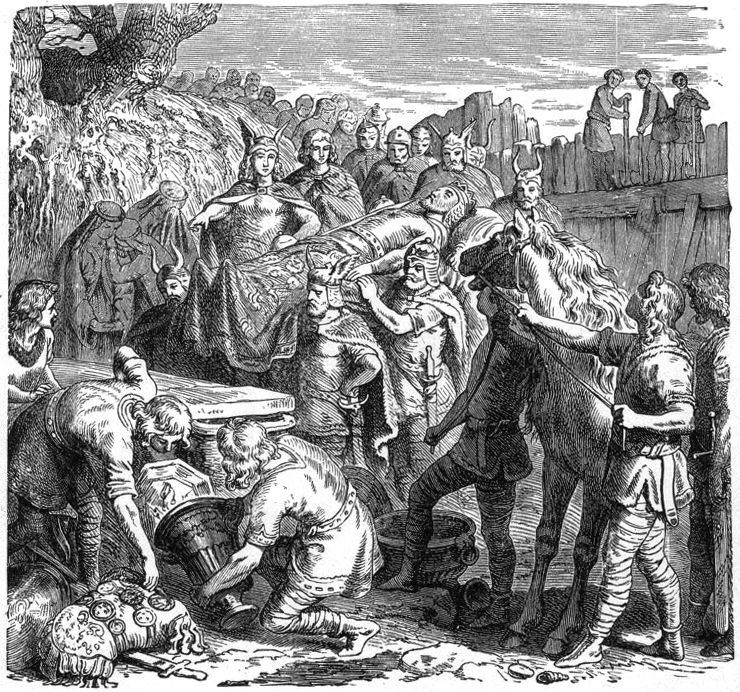648: Alaric the Goth: 4of4: An Outsider's History of the Fall of RomeHardcover – June 9, 2020. by Douglas Boin (Author)

Photo: No known restrictions on publication. The burial of Alaric in the bed of the Busento River (https://en.wikipedia.org/wiki/Busento_River) . 1895 wood engraving. Heinrich Leutemann (1824-1904). - Scanned from Ridpath, John Clark. Ridpath's Universal History. Section XII, p. 342. Captioned as "The burial of Alaric in the bed of the Busentinus". Drawing of Alaric I being buried in the bed of the Busento River. Permission details This work is in the public domain (https://en.wikipedia.org/wiki/public_domain) in its country of origin and other countries and areas where the copyright term (https://en.wikipedia.org/wiki/List_of_countries%27_copyright_lengths) is the author's life plus 70 years or fewer. You must also include a United States public domain tag (https://commons.wikimedia.org/wiki/Commons:Copyright_tags/Country-specific_tags#United_States_of_America) to indicate why this work is in the public domain in the United States. Note that a few countries have copyright terms longer than 70 years: Mexico has 100 years, Jamaica has 95 years, Colombia has 80 years, and Guatemala and Samoa have 75 years. This image may not be in the public domain in these countries, which moreover do not implement the rule of the shorter term (https://en.wikipedia.org/wiki/rule_of_the_shorter_term) . Côte d'Ivoire has a general copyright term of 99 years and Honduras has 75 years, but they do implement the rule of the shorter term. Copyright may extend on works created by French who died for France in World War II (https://en.wikipedia.org/wiki/World_War_II) (more information (https://commons.wikimedia.org/wiki/Commons:Copyright_rules_by_territory/France) ), Russians who served in the Eastern Front of World War II (https://en.wikipedia.org/wiki/Eastern_Front_(World_War_II)) (known as the Great Patriotic War in Russia) and posthumously rehabilitated (https://en.wikipedia.org/wiki/Rehabilitation_(Soviet)) victims of Soviet repressions (more information (https://commons.wikimedia.org/wiki/Template:PD-Russia) ). This file has been identified as being free of known restrictions under copyright law, including all related and neighboring rights. (https://creativecommons.org/publicdomain/mark/1.0/deed.en) View more (https://en.wikipedia.org/wiki/Alaric_I#) Public Domain (https://commons.wikimedia.org/wiki/File:Death_of_Alaric.jpg) view terms File:Death of Alaric.jpg Created: Published in 1895. http://JohnBatchelorShow.com/contact http://JohnBatchelorShow.com/schedules Parler & Twitter: @BatchelorShow Alaric the Goth: 4of4: An Outsider's History of the Fall of RomeHardcover – June 9, 2020. by Douglas Boin (https://www.amazon.com/Douglas-Boin/e/B009WS8DE6/ref=dp_byline_cont_book_1) (Author) https://www.amazon.com/Alaric-Goth-Outsiders-History-Fall/dp/0393635694/ref=tmm_hrd_swatch_0?_encoding=UTF8&qid=1604188714&sr=1-1 Stigmatized and relegated to the margins of Roman society, the Goths were violent “barbarians” who destroyed “civilization,” at least in the conventional story of Rome’s collapse. But a slight shift of perspective brings their history, and ours, shockingly alive. Alaric grew up near the river border that separated Gothic territory from Roman. He survived a border policy that separated migrant children from their parents, and he was denied benefits he likely expected from military service. Romans were deeply conflicted over who should enjoy the privileges of citizenship. They wanted to buttress their global power, but were insecure about Roman identity; they depended on foreign goods, but scoffed at and denied foreigners their own voices and humanity. In stark contrast to the rising bigotry, intolerance, and zealotry among Romans during Alaric’s lifetime, the Goths, as practicing Christians, valued religious pluralism and tolerance. The marginalized Goths, marked by history as frightening harbingers of destruction and of the Dark Ages, preserved virtues of the ancient world that we take for granted. The three nights of riots Alaric and the Goths brought to the capital struck fear into the hearts of the powerful, but the riots were not without cause. Combining vivid storytelling and historical analysis, Douglas Boin reveals the Goths’ complex and fascinating legacy in shaping our world. 12 illustrations